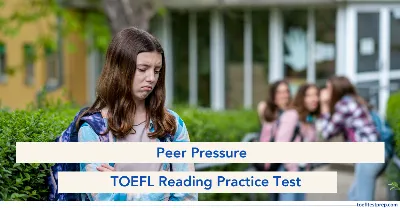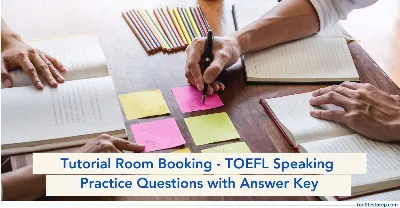Peer Pressure - TOEFL iBT® Reading Practice Test

"Boost your TOEFL Reading proficiency with practice passages on 'Peer Pressure,' exploring its role in shaping behaviour and decisions."
Peer pressure is a significant psychological and social phenomenon that affects decision-making and behaviour. In the TOEFL Reading section, topics like this often involve analysing its causes, effects, and implications in various contexts.
Practising passages on 'Peer Pressure' will enhance your ability to comprehend complex ideas, evaluate perspectives, and answer questions that require critical thinking. This focused preparation ensures you're ready to tackle similar topics on test day.
Reading Instructions:
- You have 15 minutes to read the following passage and answer all 9 questions related to it.
- Most questions are worth 1 point, but the last question is worth more. The directions indicate how many points you will receive for that specific question.
- The specific section/paragraphs have been provided again with the question for ease of understanding and quick solution.
- Some questions include a word or phrase that is highlighted in the question as well as in the paragraph for quick reference.
Peer Pressure
Peer pressure is a common social occurrence that importantly affects individual behavior, especially during adolescence. It happens when people feel the need to fit in with the views, behaviors, or values of their peers, often leading to choices that dont match their personal beliefs. This influence can appear in different settings, such as schools, social interactions, and online spaces. While peer pressure can encourage positive behaviors, like doing well in school and participating in the community, it can also lead to negative outcomes, such as substance abuse and risky activities. Understanding how peer pressure works is important for parents, teachers, and mental health professionals, as it plays a key role in shaping individual choices and social interactions.
The processes behind peer pressure are complicated and varied. Social psychologists suggest that the desire for acceptance and belonging drives individuals to match their behaviors with those of their peers. This occurrence is especially strong during adolescence, a time marked by important changes in brain structure and function. Research shows that the prefrontal cortex, responsible for decision-making and impulse control, develops significantly during this time. As a result, teenagers may favor peer approval over their personal values or long-term consequences, leading to choices they might not make when alone. For example, a teenager may choose to participate in risky behaviors, like underage drinking, mainly to fit in with a social group, even though they know the potential dangers.
Also, the rise of social media has changed the way people interact, making the effects of peer pressure even stronger. Platforms like Instagram, Snapchat, and TikTok allow for constant connection and visibility, creating an environment where individuals are very aware of their peers actions and opinions. This online aspect of peer pressure can increase feelings of lack or the need to conform, as people compare their lives to selected images of others. Studies have shown that seeing idealized images and lifestyles can lead to more anxiety and a desire to participate in behaviors that match those shown online. For example, a young person may feel pressured to adopt certain fashion trends or lifestyles highlighted by influencers, leading to financial strain or unhealthy habits.
The effects of peer pressure are not the same for everyone; they can differ based on individual traits and the specific setting. Research shows that individuals with strong self-esteem and a clear sense of identity are often better at resisting negative peer influences. On the other hand, those who struggle with self-image or social anxiety may be more likely to give in to peer pressure. Also, the nature of the peer group itself is important; groups that promote positive behaviors can encourage strength and healthy choices, while those that make normal risky behaviors can lead to bad outcomes. For instance, a supportive group of friends who focus on academic success can motivate each other to excel, whereas a group that normalizes substance use may lead to harmful choices.
Efforts to reduce the negative impacts of peer pressure have gained popularity in recent years. Educational programs that focus on building self-esteem, decision-making skills, and confidence can help individuals resist harmful influences. For example, role-playing scenarios can help teenagers practice how to respond to peer pressure in a safe setting, giving them the tools they need to make informed choices. Also, open communication between parents and children can create a preventive atmosphere where individuals feel comfortable discussing their experiences and challenges related to peer influence. Such measures can greatly lower the chances of engaging in risky behaviors. A study conducted in several schools found that students who took part in peer resistance training were less likely to use substances compared to those who did not receive such training.
In conclusion, peer pressure is a complex force that can significantly influence individual behavior, especially during the formative years of adolescence. While it can lead to both positive and negative outcomes, understanding its processes and effects is crucial for developing effective interventions. As society continues to change, especially with the rise of social media, the dynamics of peer pressure will likely evolve, requiring ongoing research and adaptation of strategies to help individuals navigate these challenges. Finally, creating environments that promote healthy peer interactions and self-acceptance can lessen the negative effects of peer pressure and empower individuals to make choices that align with their values and goals. Future research should look into the long-term effects of peer pressure on mental health and the effectiveness of various intervention strategies in different groups.
Directions: Once you have read the passage, answer the following questions.
Paragraph 1
Peer pressure is a common social occurrence that importantly affects individual behavior, especially during adolescence. It happens when people feel the need to fit in with the views, behaviors, or values of their peers, often leading to choices that don't match their personal beliefs. This influence can appear in different settings, such as schools, social interactions, and online spaces. While peer pressure can encourage positive behaviors, like doing well in school and participating in the community, it can also lead to negative outcomes, such as substance abuse and risky activities. Understanding how peer pressure works is important for parents, teachers, and mental health professionals, as it plays a key role in shaping individual choices and social interactions.
Factual Information Questions
- According to paragraph 1, what are two potential outcomes of peer pressure?
- Encouraging academic success and promoting healthy lifestyles.
- Leading to substance abuse and risky activities.
- Enhancing social skills and improving mental health.
- Fostering independence and personal beliefs.
Negative Factual Information Questions
- The author mentions all of the following as settings where peer pressure can occur EXCEPT:
- Schools
- Online spaces
- Workplaces
- Social interactions
Paragraph 2
The processes behind peer pressure are complicated and varied. Social psychologists suggest that the desire for acceptance and belonging drives individuals to match their behaviors with those of their peers. This occurrence is especially strong during adolescence, a time marked by important changes in brain structure and function. Research shows that the prefrontal cortex, responsible for decision-making and impulse control, develops significantly during this time. As a result, teenagers may favour peer approval over their personal values or long-term consequences, leading to choices they might not make when alone. For example, a teenager may choose to participate in risky behaviors, like underage drinking, mainly to fit in with a social group, even though they know the potential dangers.
Inference Questions
- What can be inferred from paragraph 2 about the relationship between brain development and peer pressure during adolescence?
- Adolescents are less likely to seek peer approval as they mature.
- The development of the prefrontal cortex makes adolescents more susceptible to peer pressure.
- The development of the prefrontal cortex makes adolescents more susceptible to peer
pressure. - Adolescents are more independent in their choices due to brain development.
Rhetorical Purpose Questions
- Why does the author include the example of a teenager participating in underage drinking in paragraph 2?
- To illustrate the positive effects of peer pressure.
- To highlight the dangers of peer pressure in adolescence.
- To suggest that all teenagers engage in risky behaviours.
- To demonstrate that peer pressure is only a concern in social settings.
Paragraph 3
Also, the rise of social media has changed the way people interact, making the effects of peer pressure even stronger. Platforms like Instagram, Snapchat, and TikTok allow for constant connection and visibility, creating an environment where individuals are very aware of their peers actions and opinions. This online aspect of peer pressure can increase feelings of lack or the need to conform, as people compare their lives to selected images of others. Studies have shown that seeing idealised images and lifestyles can lead to more anxiety and a desire to participate in behaviours that match those shown online. For example, a young person may feel pressured to adopt certain fashion trends or lifestyles highlighted by influencers, leading to financial strain or unhealthy habits.
Vocabulary Questions
- In paragraph 3, the word idealised is closest in meaning to:
- Realistic
- Perfected
- Flawed
- Ordinary
Sentence Simplification Questions
- Which of the sentences below best expresses the essential information in the following
text in paragraph 3?
Studies have shown that seeing idealised images and lifestyles can lead to more anxiety
and a desire to participate in behaviours that match those shown online.
- Viewing idealised images online can increase anxiety and conformity.
- People often feel relaxed when they see idealised images online.
- Idealised images have no effect on peoples behaviour.
- Anxiety is unrelated to the images people see on social media.
Paragraph 4
The effects of peer pressure are not the same for everyone; they can differ based on individual traits and the specific setting. Research shows that individuals with strong self-esteem and a clear sense of identity are often better at resisting negative peer influences. On the other hand, those who struggle with self-image or social anxiety may be more likely to give in to peer pressure. Also, the nature of the peer group itself is important; groups that promote positive behaviours can encourage strength and healthy choices, while those that normalise risky behaviours can lead to bad outcomes. For instance, a supportive group of friends who focus on academic success can motivate each other to excel, whereas a group that normalises substance use may lead to harmful choices.he effects of peer pressure are not the same for everyone; they can differ based on individual traits and the specific setting. Research shows that individuals with strong self-esteem and a clear sense of identity are often better at resisting negative peer influences. On the other hand, those who struggle with self-image or social anxiety may be more likely to give in to peer pressure. Also, the nature of the peer group itself is important; groups that promote positive behaviours can encourage strength and healthy choices, while those that normalise risky behaviours can lead to bad outcomes. For instance,
a supportive group of friends who focus on academic success can motivate each other to
excel, whereas a group that normalises substance use may lead to harmful choices.
Prose Summary Questions
- Which of the following best summarises the main idea of paragraph 4?
- Peer pressure affects everyone equally, regardless of their traits.
- Individual traits and peer group dynamics influence the effects of peer pressure.
- Peer pressure is only harmful in certain social settings.
- Strong self-esteem guarantees resistance to peer pressure.
Paragraph 5
Efforts to reduce the negative impacts of peer pressure have gained popularity in recent years. Educational programmes that focus on building self-esteem, decision-making skills, and confidence can help individuals resist harmful influences. For example, role-playing scenarios can help teenagers practice how to respond to peer pressure in a safe setting, giving them the tools they need to make informed choices. Also, open communication between parents and children can create a preventive atmosphere where individuals feel comfortable discussing their experiences and challenges related to peer influence. Such measures can greatly lower the chances of engaging in risky behaviours. A study conducted in several schools found that students who took part in peer resistance training were less likely to use substances compared to those who did not receive such training.
Insert Missing Sentence Question
- In paragraph 5, there is a missing sentence. The paragraph is repeated below and shows
four letters (A, B, C, and D) that indicate where the following sentence could be added. These strategies aim to empower individuals to make choices aligned with their values. Where would the sentence best fit?
- Educational programmes that focus on building self-esteem, decision-making skills, and confidence can help individuals resist harmful influences.
- For example, role- playing scenarios can help teenagers practice how to respond to peer pressure in a safe setting, giving them the tools they need to make informed choices.
- Also, open communication between parents and children can create a preventive atmosphere where individuals feel comfortable discussing their experiences and challenges related to peer influence.
- Such measures can greatly lower the chances of engaging in risky behaviours.
Paragraph 6
In conclusion, peer pressure is a complex force that can significantly influence individual behaviour, especially during the formative years of adolescence. While it can lead to both positive and negative outcomes, understanding its processes and effects is crucial for developing effective interventions. As society continues to change, especially with the rise of social media, the dynamics of peer pressure will likely evolve, requiring ongoing research and adaptation of strategies to help individuals navigate these challenges. Finally, creating environments that promote healthy peer interactions and self-acceptance can lessen the negative effects of peer pressure and empower individuals to make choices that align with their values and goals. Future research should look into the long-term effects of peer pressure on mental health and the effectiveness of various intervention strategies in different groups.
Purpose of the Passage Questions
- What is the main purpose of paragraph 6?
- To summarise the key points about peer pressure.
- To argue that peer pressure is solely negative.
- To suggest that peer pressure is a new phenomenon.
- To highlight the importance of social media in peer interactions.
Prose Summary Questions
Directions: An introductory sentence for a brief summary of the passage is provided below. Complete the summary by selecting the THREE answer choices that express the most important ideas in the passage. Some sentences do not belong in the summary because they express ideas that are not presented in the passage or are minor ideas in the passage. This question is worth 2 points.
- Peer pressure significantly influences individual behaviour, particularly during adolescence.
- Peer pressure can lead to both positive and negative outcomes.
- Social media has intensified the effects of peer pressure.
- Individuals with strong self-esteem are less affected by peer pressure.
- Peer pressure is only a concern in educational settings.
- Educational programmes can help individuals resist negative peer influences.
Answer Key with Explanation for TOEFL Reading Passage - Peer Pressure
Here are the answers and explanations for the questions based on the provided passage about peer pressure:
1. Answer: B
Explanation: In paragraph 1, the author explicitly states that peer pressure can lead to negative outcomes such as substance abuse and risky activities. This directly aligns with option B, making it the correct choice. The other options either mention positive outcomes or are not supported by the text.
2. Answer: C
Explanation:The passage lists schools, social interactions, and online spaces as settings where peer pressure can occur. However, it does not mention workplaces, making option C the correct answer. This indicates that the author did not consider workplaces as a primary context for peer pressure.
3. Answer: B
Explanation:Paragraph 2 discusses how the prefrontal cortex, which is crucial for decision-making and impulse control, develops significantly during adolescence. This development can lead teenagers to prioritize peer approval over personal values, suggesting that they become more susceptible to peer pressure as their brains mature.
4. Answer: B
Explanation:The example of a teenager participating in underage drinking serves to illustrate the potential dangers associated with peer pressure during adolescence. It emphasizes the negative consequences that can arise when individuals prioritize fitting in over their safety and well-being.
5. Answer: B
Explanation:In paragraph 3, idealised refers to images that are portrayed as perfect or flawless. Therefore, "perfected" is the closest synonym, as it conveys the idea of something being made to appear better than it is, which aligns with the context of social media portrayals.
6. Answer: A
Explanation:This option succinctly captures the essential information from the original sentence, summarizing the impact of idealised images on anxiety and the desire to conform. The other options either misrepresent the information or contradict the findings presented in the paragraph.
7. Answer: B
Explanation:Paragraph 4 discusses how individual traits, such as self-esteem, and the dynamics of peer groups affect how peer pressure is experienced. This encapsulates the main idea of the paragraph, while the other options do not accurately reflect the content.
8. Answer: B
Explanation:The missing sentence fits best after the mention of educational programmes in sentence B. It logically follows the discussion about these programmes aiming to build skills and confidence, reinforcing the idea that they empower individuals to make choices aligned with their values.
9. Answer: B
Explanation: The main purpose of paragraph 6 is to summarise the complexities of peer pressure and its implications, as well as to highlight the need for ongoing research and effective interventions. The other options do not accurately reflect the comprehensive nature of the paragraph.
10. Answer: A, B, and E
Explanation:The main purpose of paragraph 6 is to summarise the complexities of peer pressure and its implications, as well as to highlight the need for ongoing research and effective interventions. The other options do not accurately reflect the comprehensive nature of the paragraph.
Also Read:
- New Language - TOEFL Speaking Independent Practice Test Paper with Responses
- Serengeti Herbivores - TOEFL Reading Practice Test Paper with Answers
- The Easter Island - TOEFL Reading Practice Questions with Answer Key
- Theory of Evolution - TOEFL Reading Practice Test with Answer Key
- Microplastics - TOEFL iBT® Reading Practice Test with Answer Key
Featured Articles

Marriage Across Cultures - TOEFL Reading Practice Test
Improve TOEFL Reading with passages on 'Marriage Across Cultures,' delving into unique traditions, values, and global perspectives on marriage.
July 15, 2025
Writing Center Services - TOEFL Speaking Practice Test with Answers (Integrated)
Prepare for the TOEFL Integrated Speaking section with a practice test on 'Writing Center Services' and learn to improve score in TOEFL exam.
July 15, 2025
Tutorial Room Booking - TOEFL Speaking Practice Test with Answers (Integrated)
Prepare for the TOEFL Integrated Speaking section with a practice test on 'Tutorial Room Booking ' and learn to improve score in TOEFL exam.
July 15, 2025
Textbook Rental System - TOEFL Speaking Practice Test with Answers (Integrated)
Prepare for the TOEFL Integrated Speaking section with a practice test on 'Textbook Rental System' and learn to improve score in TOEFL exam.
July 15, 2025